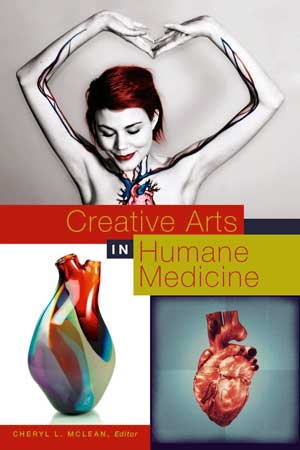Mary Ann McDermott
Chicago, Illinois, United States

McLean’s new book is for all those interested in healthcare and the arts. The book compiles programming descriptions, “how to” instructions, small research studies, personal memoirs, and short essays by medicine, nursing, and dentistry professionals as well as by patients, social service professionals, artists, students, and others!
The book is divided into four sections. In Section 1, submissions explore the challenges of developing empathy through the arts. A number of examples of coursework, international in scope, are provided. For example, a seminar in the visual arts for dental students at the University of Melbourne is described in such detail as to facilitate the replication of the course elsewhere. In Section 2, authors describe the use of readers’ theater, literature and reflection, music performance, and visual art methodology to promote practitioner and team self-care. I found the description of an “artist in residence” program at a UK medical school’s anatomy lab particularly fascinating: assignments included a session on composing a pictorial map that will lead to a hypothetical diagnosis and a workshop that engages students in “observing, drawing, and tracing their visual, intellectual and emotional encounters” in the lab. Section 3 features the use of the narrative in navigating the life experiences of practitioners, teachers, and patients. In one entry, a nurse educator relates how her own story of illness led to a small qualitative research study of her colleagues using the narrative inquiry reflective process.
Advocacy is the theme of Section 4 where authors examine how the arts and arts-based inquiry can be used as an impetus for change in health and in health care. Course work content described in this section includes legal, ethical, anti-violence issues that teach students to “think again” and to recognize that there is not always a “right answer.” Several assignments caught my eye, particularly these two: The development of ten-minute digital YouTube videos about health care and an initiative entitled Heartfelt Images for which medical and fine arts students co-created art for the bare walls of community health centers in Vancouver.
Five brief entries entitled “Lifelines” were scattered throughout the book. I found one rather “edgy”! “Theater of Operations” in the “Advocacy” section related the work on a recent project by two Canadian artists working with the trade union movement and galleries to display eleven portraits of health care workers in different job categories. These portraits were interspersed with historical images and quotations from the workers as well as from consumers of care.
All submissions incorporated extensive literature reviews, which will well serve the reader who wishes to delve more thoroughly into specific content. Several entries discussed the evolution of the medical humanities in medical education, and most cited challenges to implementation of the arts in health care education: financial concerns, student and faculty cynicism, time constraints within the curriculum, and grading. My conclusion: the integration of the arts into health care professional education remains a marginalized field, but best practices in this field abound!
Creative Arts in Humane Medicine
Cheryl L. McLean, Editor
Canada: Brush Education Inc., 2014
ISBN 978-1-55059-454-6 (pbk)
Available for sale on Amazon and Barnes & Noble
RN, EdD, FAAN, is Professor Emerita, Niehoff School of Nursing Loyola University Chicago. She enjoyed many roles at Loyola over 40 plus years. She is currently employed part time as a nurse educator by Hines Veterans Administration Hospital, Hines, Illinois working with their nurse residency program. She is interested in how the arts and the humanities can renew and refresh nurses and has led educational tours to Rome, Italy where Loyola University has a campus for the last two decades. She is a founding member of the Hektoen Nurses and the Humanities group.
Highlighted in Frontispiece Volume 6, Issue 3 – Summer 2014

Leave a Reply